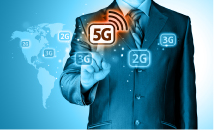5G: Too Good to be True?
By: Finbarr Travers

With trials and commercial deployments of 5G already underway and many CSPs expecting to deploy 5G technology in the next one to two years, the promise of 5G is fast becoming a reality. Data speeds of up to 20 times faster than existing LTE deployments at 10 or even 20 gigabits per second will make new apps and services—such as ultra-HD video and fixed wireless Internet—a reality over the mobile network. Low latency data transmission of 1 millisecond, making data connection and transmission almost instantaneous, will become commonplace and enable a whole new wave of services.
Due to the higher frequency of 5G (above 6GHz) and the additional available bandwidth, several orders of magnitude more connections can be supported per square kilometer. These additional connections will become critical as more and more IoT devices are supported. Even now, applications like ‘smart’ appliances, home security systems and connected cars are driving up the number of connections needed. The high-frequency ranges of 5G will also allow for improved efficiency and reduced interference through the use of beamforming, where cellular signals can be targeted at individual customers or devices, reducing interference and allowing more information to be exchanged between the subscriber and the network.
Through virtualization of networks and the implementation of network slicing, CSPs will be able to dedicate specific network resource profiles to specific services: for example, higher bandwidth for ultra-high definition video streaming versus low latency and guaranteed connectivity for gaming. In addition, the network and service reliability will be significantly improved through virtualization of the networks, network slicing and various requirements included in the 5G specification, providing five 9’s availability. All of this will come at a lower cost to CSPs by moving away from macro-cell architecture to more distributed small cell deployments that are less costly to build and have a smaller footprint.
New Monetization Opportunities
The promise of 5G will create many opportunities for CSPs to generate new revenue streams by improving current services and creating new ones. These opportunities include:
- Enhanced wireless broadband
- Fixed wireless Internet offered to homes and enterprises
- Support for services that require higher bandwidth and consistent connectivity, such as ultra-high definition video streamed directly to your device, virtual and augmented reality applications, fully autonomous or semi-autonomous vehicles, or drones
- IoT everywhere—smart appliances, connected homes and enterprises, cars, and smart cities. 5G’s ability to handle millions of connections per square kilometer will enable this.
- Mission-critical applications that require reliable and low latency connectivity: for example, telemedicine surgery being performed remotely.
- New applications and innovations
Sounds too good to be true. What’s the catch?
The Technical Challenges of 5G
As with any major technology shift, the move to 5G comes with a number of technical and business challenges which operators will need to address. First and foremost, the 5G standard has only been recently defined and will see many iterations as 5G technologies are implemented and evolve.





















